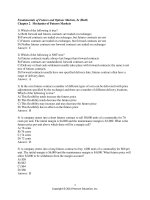Fundamentals of Futures and Options Markets, 7th Ed, Ch 3
Bạn đang xem bản rút gọn của tài liệu. Xem và tải ngay bản đầy đủ của tài liệu tại đây (113.16 KB, 17 trang )
Hedging Strategies Using
Futures
Chapter 3
Fundamentals of Futures and Options Markets, 7th Ed, Ch3, Copyright © John C. Hull 2010
1
Long & Short Hedges
A
long futures hedge is appropriate when
you know you will purchase an asset in
the future and want to lock in the price
A short futures hedge is appropriate
when you know you will sell an asset in
the future & want to lock in the price
Fundamentals of Futures and Options Markets, 7th Ed, Ch3, Copyright © John C. Hull 2010
2
Arguments in Favor of Hedging
Companies should focus on the main
business they are in and take steps to
minimize risks arising from interest
rates, exchange rates, and other market
variables
Fundamentals of Futures and Options Markets, 7th Ed, Ch3, Copyright © John C. Hull 2010
3
Arguments against Hedging
Shareholders
are usually well diversified
and can make their own hedging decisions
It may increase risk to hedge when
competitors do not
Explaining a situation where there is a loss
on the hedge and a gain on the underlying
can be difficult
Fundamentals of Futures and Options Markets, 7th Ed, Ch3, Copyright © John C. Hull 2010
4
Convergence of Futures to Spot
(Hedge initiated at time t1 and closed out at time t2)
Futures
Price
Spot
Price
Time
t1
t2
Fundamentals of Futures and Options Markets, 7th Ed, Ch3, Copyright © John C. Hull 2010
5
Basis Risk
Basis
is the difference between
spot & futures
Basis risk arises because of
the uncertainty about the basis
when the hedge is closed out
Fundamentals of Futures and Options Markets, 7th Ed, Ch3, Copyright © John C. Hull 2010
6
Long Hedge
Suppose
that
F1 : Initial Futures Price
F2 : Final Futures Price
S2 : Final Asset Price
You hedge the future purchase of an
asset by entering into a long futures
contract
Cost of Asset=S2 – (F2 – F1) = F1 + Basis
Fundamentals of Futures and Options Markets, 7th Ed, Ch3, Copyright © John C. Hull 2010
7
Short Hedge
Suppose
that
F1 : Initial Futures Price
F2 : Final Futures Price
S2 : Final Asset Price
You
hedge the future sale of an asset by
entering into a short futures contract
Price Realized=S2+ (F1 – F2) = F1 + Basis
Fundamentals of Futures and Options Markets, 7th Ed, Ch3, Copyright © John C. Hull 2010
8
Choice of Contract
Choose
a delivery month that is as close
as possible to, but later than, the end of
the life of the hedge
When there is no futures contract on the
asset being hedged, choose the contract
whose futures price is most highly
correlated with the asset price. There are
then 2 components to basis
Fundamentals of Futures and Options Markets, 7th Ed, Ch3, Copyright © John C. Hull 2010
9
Optimal Hedge Ratio
Proportion of the exposure that should optimally be
hedged is
h
S
F
where
S is the standard deviation of S, the change in the
spot price during the hedging period,
F is the standard deviation of F, the change in the
futures price during the hedging period
is the coefficient of correlation between S and F.
Fundamentals of Futures and Options Markets, 7th Ed, Ch3, Copyright © John C. Hull 2010
10
Tailing the Hedge
Two way of determining the number of contracts
to use for hedging are
Compare the exposure to be hedged with the value of
the assets underlying one futures contract
Compare the exposure to be hedged with the value of
one futures contract (=futures price time size of
futures contract
The second approach incorporates an
adjustment for the daily settlement of futures
Fundamentals of Futures and Options Markets, 7th Ed, Ch3, Copyright © John C. Hull 2010
11
Hedging Using Index Futures
(Page 63)
To hedge the risk in a portfolio the
number of contracts that should be
shorted is
VA
VF
where VA is the current value of the
portfolio, is its beta, and VF is the
current value of one futures (=futures
price times contract size)
Fundamentals of Futures and Options Markets, 7th Ed, Ch3, Copyright © John C. Hull 2010
12
Reasons for Hedging an Equity
Portfolio
Desire
to be out of the market for a short
period of time. (Hedging may be cheaper
than selling the portfolio and buying it
back.)
Desire to hedge systematic risk
Fundamentals of Futures and Options Markets, 7th Ed, Ch3, Copyright © John C. Hull 2010
13
Example
Futures price of S&P 500 is 1,000
Size of portfolio is $5 million
Beta of portfolio is 1.5
One contract is on $250 times the index
What position in futures contracts on the
S&P 500 is necessary to hedge the
portfolio?
Fundamentals of Futures and Options Markets, 7th Ed, Ch3, Copyright © John C. Hull 2010
14
Changing Beta
What
position is necessary to reduce the
beta of the portfolio to 0.75?
What position is necessary to increase the
beta of the portfolio to 2.0?
Fundamentals of Futures and Options Markets, 7th Ed, Ch3, Copyright © John C. Hull 2010
15
Stock Picking
If
you think you can pick stocks that will
outperform the market, futures contract
can be used to hedge the market risk
If you are right, you will make money
whether the market goes up or down
Fundamentals of Futures and Options Markets, 7th Ed, Ch3, Copyright © John C. Hull 2010
16
Rolling The Hedge Forward
We
can use a series of futures
contracts to increase the life of a
hedge
Each time we switch from 1 futures
contract to another we incur a type of
basis risk
Fundamentals of Futures and Options Markets, 7th Ed, Ch3, Copyright © John C. Hull 2010
17









